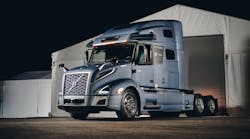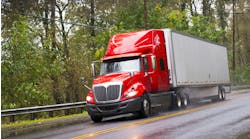Volvo Trucks shared a glimpse of its self-driving truck future in North America. After cementing a partnership with Aurora earlier this year, Volvo Autonomous Solutions unveiled the first look at a long-haul Volvo VNL 760 integrated with Aurora Driver technology.
The first Volvo self-driving Class 8 tractor is a step toward Volvo Trucks North America offering autonomous trucks to fleet “customers, as well as delivering comprehensive and seamless Transport as a Service (TaaS) solutions for autonomous, commercial trucks, tailored to specific customer needs,” Sasko Cuklev, head of on-road solutions for Volvo Autonomous Solutions, told FleetOwner.
Volvo, on Sept. 28, unveiled the first looks at the new truck by releasing some photos and a video that touts its brewing autonomous solutions with Aurora's technology integrated into the self-driving long-haul truck.
Research and development of the autonomous VNL are supported by global team efforts, according to Volvo Group. The on-highway autonomous truck applications are being designed and engineered in the U.S. in preparation for future production at Volvo Trucks’ New River Valley Assembly Operations in Dublin, Virginia. “The two engineering teams are collaborating to design the Volvo VNL architecture and integrating the Aurora Driver in the truck,” Cuklev said.
He added that “automation is a key technology for the Volvo Group,” which has been working with Aurora since 2018. Most of that work had centered on autonomous pilot projects in Europe until earlier in 2021.
“Despite our early progress, our shared values, and our common goal, both Volvo and Aurora had work to do before we could field a serious product in high-speed trucking,” Sterling Anderson, Aurora co-founder and chief product officer, said in March. “Aurora’s sensor suite, like the rest of the industry, could not robustly see far enough to safely drive a Class 8 truck at highway speeds; and Volvo needed to lay the groundwork for an autonomous solutions business. Driven by our interest in trucking and our desire to build an extraordinary product together, we got to work.”
After those early successes with pilot projects, Volvo and Aurora entered a long-term partnership this spring. “Our first commercial truck with Volvo will be adapted to the requirements of the Aurora Driver and tailored to the demands of an autonomous hub-to-hub use case,” Anderson said of the partnership earlier this year. “These trucks will combine the best of Volvo’s technology with the Aurora Driver, which uniquely has the ability to detect and track objects well beyond 300 meters into a compelling and scalable logistics platform.”
Safety standards
Anderson noted the Volvo Group’s nearly 100 years of setting trucking industry safety standards, which drew the trucking technology company to the OEM. Cuklev added that “safety is paramount for autonomous vehicles and is at the core of all the Volvo Group’s innovations.”
“The transformation to autonomous is rooted in this experience and builds on proven safety technologies already in place on the Volvo VNL, including Volvo Dynamic Steering (VDS) and automated transmission (I-Shift),” Cuklev said. “These existing technologies, along with a number of other advanced vehicle features, create a redundant, safety-based solution in the autonomous truck’s core systems to ensure safe operations are in place.”
The foundation of these Volvo Trucks’ safety systems combined with the Aurora Driver technology focuses on safety at every step of the development process, according to Volvo Group.
“We are proud that our Volvo VNL model will serve as the foundation for the development of North American autonomous trucks to offer our customers the next generation of safe, efficient, and sustainable transport solutions,” said Peter Voorhoeve, president of Volvo Trucks North America.
Contributing to a more sustainable society is another driving force of Volvo Autonomous Solutions’ strategy. Bringing autonomous Volvo on-highway trucks to market will complement today’s transport system to help meet the increasing demand for moving goods while minimizing the environmental impact.
“Volvo Autonomous Solutions is proud to take our first, major steps toward the autonomous Volvo VNL in North America,” Nils Jaeger, president of Volvo Autonomous Solutions, said in a press release. “Our long-standing customer base and their priorities are at the forefront of our path forward in shaping autonomous trucking. We strongly believe in a future in which safe, sustainable, efficient transport solutions are essential for any society to prosper, and autonomous commercial trucking is an important piece of that transformation.”
As Volvo Autonomous Solutions and Aurora continue to make progress with the Volvo VNL prototype digitally revealed this fall, the companies are working toward the next step in implementing their hub-to-hub transport vision in North America. This includes identifying specific regions and routes to serve as the initial hubs for on-road highway testing.
“Through this partnership, we are aiming to accelerate the development of the technology and go-to-market strategy, as well as strengthen our long-term capabilities and assets within automation to benefit customers in different segments and markets,” Cuklev added.
Fleet future
In addition, Volvo Autonomous Solutions is working with fleet customers to understand their current and future needs, priorities and demands, in preparation for piloting the autonomous Volvo VNL in on-road, hub-to-hub transport scenarios, as well as the eventual adoption of autonomous technology commercially.
Where those first self-driving VNLs take off is still to be decided, Cuklev told FleetOwner. “There are ongoing discussions but nothing that we can reveal at this point,” he said. “The preliminary focus will be on Class 8 long-haul, with specifically predetermined routes that are traversed repetitively.”
Because “safety is at the heart of everything we do at Volvo Trucks and Volvo Autonomous Solutions,” testing will begin with a safety driver on board these autonomous VNLs, Cuklev said. “A safety driver will always be on board in the initial validation stages. We aim at being one of the first in the industry to deliver fully autonomous solutions to our customers.”





